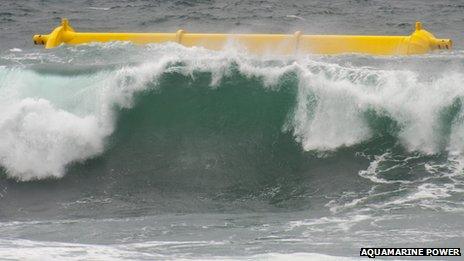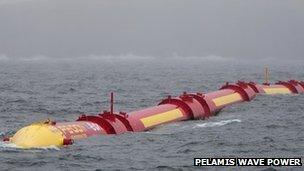Scotland's first marine energy park launched
- Published

The energy park aims to encourage further progress in marine power development
Scotland's first marine energy park has been launched.
The Pentland Firth and Orkney Waters Marine Energy Park aims to help boost progress in marine power development.
The venture will include the European Marine Energy Centre (Emec) on Orkney, where testing of a range of wave and tidal devices is already under way.
Earlier this year, the government announced the UK's first such marine energy park off the south-west of England.
The park designation is designed to link university researchers and private companies working in marine energy.
The Scottish park was officially launched by UK Energy Minister Greg Barker at the Caithness port of Scrabster.
Scottish Energy Minister Fergus Ewing said the designation would further enhance Scotland's position in marine renewables.
He added: "Progress in Scottish wave and tidal renewables has been staggering, but the Scottish government recognises that more financial support is needed to help the sector achieve its fullest potential.
"That is why we have committed over £30m (including) investment at Emec, and why we are still continuing to invest in the sector with the £18m Marine Renewables Commercialisation Fund created to accelerate the development and deployment of commercial arrays."

Renewable power companies have been developing the Pelamis wave device
Industry body Scottish Renewables said the designation would support thousands of jobs.
WWF Scotland welcomed the news that the Pentland Firth was set to be named as the UK's second marine energy park.
Policy officer Dr Sam Gardner described it as "an exciting development and a further opportunity for Scotland's marine renewable sector to develop wave and tidal devices".
He added: "We are already at the forefront of these important technologies and energy park status will help further speed up the commercial development of marine renewables.
"With careful planning we can harness Scotland's wave and tidal energy to help cut our climate emissions, while safeguarding the nation's tremendous marine environment."
Device testing
Emec's 14-berth wave and tidal test and research centre has attracted a range of projects over the past few years.
Since 2009, Edinburgh-based Aquamarine Power has deployed and tested two full-scale Oyster devices, which use wave power technology to capture energy found in near-shore waves.
Martin McAdam, of Aquamarine Power, said: "The new Marine Energy Park confirms the region's status as a world leader in wave and tidal technology and will - we anticipate - accelerate the industry's and the region's ambitions for commercial success, new jobs and economic growth."
Finnish company Wello Oy is also testing its Penguin wave energy converter, while energy firm Vattenfall has secured a test berth at the Billia Croo wave test site in Orkney where they intend to test the latest generation Pelamis Wave Power device in 2014.
ScottishPower Renewables and E.On are also working together with the Pelamis P2 device at adjacent test berths in an effort to learn from operating and maintaining the machines as a wave farm.
Richard Yemm, commercial director and founder of Pelamis Wave Power, said the park help to create a "more solid platform" for commercialisation of the sector in Scottish waters.
He added: "Collectively, Pelamis and our customers E.ON and ScottishPower Renewables are developing 200MW of wave farm projects within the new Marine Energy Park.
"Today's announcement further underpins our commitment to this region, and puts in place another cornerstone for the next stages of our commercial development."
Emec's tidal clients include Kawasaki Heavy Industries, which signed up to a berth at the Fall of Warness tidal test site in October.
Kawasaki has been developing a tidal stream energy converter in-house since 2010 and plans to begin testing their device at Emec in 2013/14.
According to the Department for Energy and Climate Change, energy from the waves or tides has the potential to generate up to 27GW of power in the UK alone by 2050, equivalent to the power generated from eight coal-fired power stations.
- Published23 May 2012
- Published17 May 2012
- Published15 March 2012
- Published13 February 2012